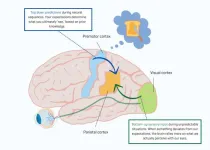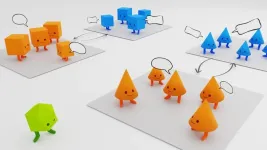(Press-News.org) When we see what others do, our brain sees not what we see, but what we expect
When we engage in social interactions, like shaking hands or having a conversation, our observation of other people’s actions is crucial. But what exactly happens in our brain during this process: how do the different brain regions talk to each other? Researchers at the Netherlands Institute for Neuroscience provide an intriguing answer: our perception of what others do depends more on what we expect to happen than previously believed.
For some time, researchers have been trying to understand how our brains process other people’s actions. It is known, for example, that watching someone perform an action activates similar brain areas compared to when we perform that action ourselves. People assumed these brain regions become activated in a particular order: seeing what others do first activates visual brain regions, then later, parietal and premotor regions we normally use to perform similar actions. Scientists thought that this flow of information, from our eyes to our own actions, is what makes us understand what others do. This belief is based on measurements of brain activity in humans and monkeys while they watched simple actions, such as picking up a knife, presented in isolation in the lab. In reality, actions don't usually happen in isolation, out of the blue: they follow a predictable sequence with an end-goal in mind, like making breakfast. How does our brain deal with this?
Chaoyi Qin, Frederic Michon and their colleagues, led by Christian Keysers and Valeria Gazzola provide us with an intriguing answer: if we observe actions in such meaningful sequences, our brains increasingly ignore what comes into our eyes, and depend more on predictions of what should happen next, derived from our own motor system. “What we would do next, becomes what our brain sees”, summarizes Christian Keysers, a senior author of the study and director of the social brain lab in the institute. To arrive at that counterintuitive conclusion, the team, in collaboration with the Jichi Medical University in Japan, had the unique opportunity to measure brain activity directly from the brain of epilepsy patients who participated in intracranial eeg-research for medical purposes. Such an examination involves measuring the brain's electrical activity using electrodes that are not on the skull, but under it.
Unique opportunity
The advantage of this technique is that it is the only technique that allows to directly measure the electrical activity the brain uses to work. Clinically, it is used as a final step for medication-resistant epilepsy patients, as it can determine the exact source of epilepsy. But while the medical team waits for epileptic seizures to occur, these patients have a period in which they have to stay in their hospital bed and have nothing to do but wait - researchers used this period as an opportunity to peak into the working of the brain with unprecedented temporal and spatial accuracy.
During the experiment, participants performed a simple task: they watched a video in which someone performed various daily actions, such as preparing breakfast or folding a shirt. During that time, their electrical brain activity could be measures through the implanted electrodes across the brain regions involved in action observation to examine how they talk to each other. Two different conditions were tested, resulting in differing brain activity while watching. In one, the video was shown – as we would normally see the action unfold every morning – in its natural sequence: you see someone pick a bread-roll, then a knife, then cut open the roll, then scoop some butter etc.; in the other, these individual acts were re-shuffled into a random order. People saw the exact same actions in the two conditions, but only in the natural order, can their brain utilize its knowledge of how it would butter a bread-roll to predict what action comes next.
Different flow of information
Using sophisticated analyses in collaboration with Pascal Fries of the Ernst Strüngmann Institute (ESI) in Germany, what the team could reveal is that when participants viewed the reshuffled, unpredictable sequence, the brain indeed had an information flow going from visual brain regions, thought to describe what the eye is seeing, to parietal and premotor regions, that also controls our own actions – just as the classical model predicted. But when participants could view the natural sequences, the activity changed dramatically. “Now, information was actually flowing from the premotor regions, that know how we prepare breakfast ourselves, down to the parietal cortex, and suppressed activity in the visual cortex”, explains Valeria Gazzola. “It is as if they stopped to see with their eyes, and started to see what they would have done themselves”.
Their finding is part of wider realization in the neuroscience community, that our brain does not simply react to what comes in through our senses. Instead, we have a predictive brain, that permanently predicts what comes next. The expected sensory input is then suppressed. We see the world from the inside out, rather than from the outside in. Of course, if what we see violates our expectations, the expectation-driven suppression fails, and we become aware of what we actually see rather than what we expected to see.
Source: Cell reports
END
Increased vigilance for high blood pressure and diffuse stomach pain. These are some of the characteristics of emergency care adapted for pregnant women and new mothers. The model, which could become clinical routine throughout Sweden, is described in a thesis at the University of Gothenburg.
The aim of the thesis was to reduce morbidity and mortality among pregnant women and new mothers seeking emergency care. Sweden has relatively low rates of pregnancy-related morbidity and mortality, but pregnant women and new mothers do not currently receive ...
A low-fat vegan diet that includes soy fosters changes in the gut microbiome that decrease postmenopausal vasomotor symptoms, or hot flashes, overall by 95%, according to a new study by the Physicians Committee for Responsible Medicine. A vegan diet also eliminated severe hot flashes, led to a 96% decrease in moderate-to-severe hot flashes, and reduced daytime and nighttime hot flashes by 96% and 94%, respectively. Participants also lost 6.4 pounds on average.
“Women who want to fight hot flashes should feed the bacteria in their gut a vegan diet rich in fruits, vegetables, grains, and beans, which also leads to weight loss and protects against heart disease and type 2 diabetes,” ...
An existing drug that targets senescent, or sleeping cells could provide the answer to treating lower back pain, according to a new study.
The research, published today as a Reviewed Preprint in eLife, advances our understanding of the role of senescent osteoclasts – cells that break down and remove damaged bone tissue – in the development of lower back pain, which affects 8 in 10 people at some point in their lives. eLife’s editors say the study provides compelling evidence that an existing drug, Navitoclax, can eliminate senescent osteoclasts in mice and, in doing so, markedly reduce spinal pain.
Osteoclasts resorb ...
GRAND RAPIDS, Mich. (Nov. 14, 2023) — A first-of-its-kind study has identified overactive inflammation and loss of critical protection mechanisms in the brain as potential contributors to suicide risk.
The findings support further exploration of anti-inflammatory medications to reduce risk, especially in situations where suicidal ideation can be ascertained early.
The study was published in the journal Molecular Psychiatry and led by Van Andel Institute’s Lena Brundin, M.D., Ph.D., Columbia ...
An international team has for the first time researched the longevity of neutralizing antibodies in HIV-1-infected people. Currently, it is assumed that an HIV-1 vaccine can only be effective if it produces these antibodies in vaccinated humans. The findings improve understanding of the dynamics of such antibodies and are an important building block for further research into an HIV-1 vaccine. Professor Dr Florian Klein, Director of the Institute of Virology at the University Hospital Cologne, and Dr Dr Philipp Schommers, Head of the Laboratory for Antiviral Immunity at Department ...
Language has the power to shape our perceptions and interactions with the world. Different languages can coexist, but their dynamics are shaped by the communities that speak them – and how those communities interact with each other. Shared beliefs, assumptions, and feelings toward specific language forms often determine whether a specific language will survive or disappear, especially within multilinguistic societies.
In Chaos, by AIP Publishing, researchers from the University of the Balearic Islands in Spain incorporate language ideologies, along with the impact of interaction between individuals with opposing preferences, on the language shift process.
“Our ...
Distributed cloud storage is a hot topic for security researchers around the globe pursuing secure data storage, and a team in China is now merging quantum physics with mature cryptography and storage techniques to achieve a cost-effective cloud storage solution.
Shamir’s secret sharing, a known method, is a key distribution algorithm. It involves distributing private information to a group so that “the secret” can be revealed only when a majority pools their knowledge. It’s common to combine quantum key distribution (QKD) and Shamir’s secret sharing algorithm for secure ...
WASHINGTON, Nov. 14, 2023 – The risk of hearing loss does not come just from loud machinery or other obvious noise. It can also affect people in public environments like theaters and concert halls. Absorbing this excess sound to make public environments safer for hearing and using the unwanted sound waves to create electricity is the aim of a paper published this week in Physics of Fluids, by AIP Publishing.
“According to the Centers for Disease Control and Prevention, an estimated 12.5% of children and adolescents aged 6-19 years and 17% of adults aged 20-69 years have suffered permanent ...
About The Study: This study of 139,000 respiratory hospitalizations in Canada of children younger than age 18 found a substantial decrease in severe respiratory disease resulting in hospitalizations, intensive care unit admissions, and mortality during the first two years of the pandemic compared with the three pre-pandemic years. These findings suggest that future evaluations of the effect of public health interventions aimed at reducing circulating respiratory pathogens during non-pandemic periods of increased respiratory illness may be warranted.
Authors: Eyal Cohen, M.D., M.Sc., of ...
About The Study: In this study where the majority of 54,000 participants were African American with low socioeconomic status, diabetes was associated with elevated colorectal cancer (CRC) risk, suggesting that diabetes prevention and control may reduce CRC disparities. The association was attenuated for those who completed colonoscopies, highlighting how adverse effects of diabetes-related metabolic dysregulation may be disrupted by preventative screening.
Authors: Shaneda Warren Andersen, Ph.D., of the University of Wisconsin, Madison, is the corresponding author.
To access the embargoed study: Visit our For The Media website at this link https://media.jamanetwork.com/
(doi:10.1001/jamanetworkopen.2023.43333)
Editor’s ...




